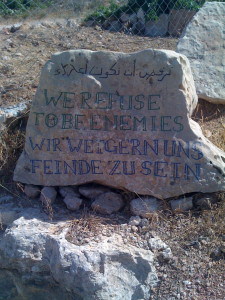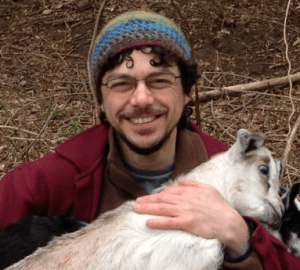By Rabbi David Seidenberg
“May the Merciful One turn our hearts toward the land, so that we may dwell together with her in her Sabbath-resting, the whole year of the Shmita!” Harachaman hu yashiv libeinu el ha’aretz l’ma’an neishev yachad imah b’shovtah kol sh’nat hash’mitah!
It was erev Rosh Hashanah – just before the Shmita year began – when I wrote this prayer to add to Birkat Hamazon (the blessing after meals) during the Shmita or Sabbatical year. I was trying for months to come up with a blessing for the Shmita, but it just wouldn’t come. It works that way for me: I can only feel the quality of a particular holy time or season when that time is upon me. It is a kind of living in the present that can be wonderful, and it can make ritual enormously fun and truly profound, even if it makes meeting deadlines harder.
When I wrote this blessing, I also prayed in my heart that these words would not just be beautiful, but that they would actually be something I could experience, this year, in Israel. So when the opportunity came to join a delegation to a Palestinian farm to replant fruit trees that had been removed by the IDF last spring (in the middle of a dispute with Israel’s government), my heart jumped at the chance to become involved.
Now, I should tell you a few things about this farm, and a few things about the Shmita year. About the farm: The first thing is that the Nassar family has owned and lived on this farm since long before the establishment of the state of Israel – I saw the caves that had been carved out of the land as dwellings long ago, as was once the custom, which are now used as classrooms and a chapel. The second is that when you enter the farm, the first thing you see is a sign painted on a stone that says, “We refuse to be enemies.”  And the third thing is that the Nassar family has turned the farm into an educational center for non-violence, called the Tent of Nations, and that Daoud Nassar runs a summer camp for poorer Palestinian children there. The last is that my own boy, Chanina, had the privilege and joy of participating in that camp for one day in the summer of 2012 while his parents toured the camp, and it was a wonderful thing for us to witness.
And the third thing is that the Nassar family has turned the farm into an educational center for non-violence, called the Tent of Nations, and that Daoud Nassar runs a summer camp for poorer Palestinian children there. The last is that my own boy, Chanina, had the privilege and joy of participating in that camp for one day in the summer of 2012 while his parents toured the camp, and it was a wonderful thing for us to witness.
I should also tell you a few things about Shmita: The first two are that Jews are not supposed to farm the land at all in the Shmita year (even to water trees), and that anything that grows belongs to everyone, and even to the wild animals (even to the point of leaving all fences open). The third is that even though Jews are not supposed to farm the holy land in the Shmita year, Jewish law says that non-Jews are completely permitted to do so, and that Jews are allowed to help non-Jews with their farms. This detail led to the enormous legal fiction used from the time of Rav Kook of selling the entire land of Israel to an Arab person every seven years, so that everyone Jewish would be farming Arab land. (This loophole is still used by most but not all religious Jewish farmers. Though it subverts the whole purpose of Shmita, it could be a meaningful thing, if it were a way of acknowledging that the holy land is the land of all our peoples.)
The same detail made me think at first that I could plant fruit trees if I were doing it on behalf of a Palestinian farmer, even if it was in the holy land. And the land where the Tent of Nations dwells is most definitely in the holy land, near Beit Lechem (Bethlehem), land that was once upon a time part of the kingdom of Judea. But what if I was wrong? I decided to ask my rabbi friends.
One rabbi said that it was a violation of Palestinian rights to call that land holy land, i.e. Jewish land, because Jewish law shouldn’t even apply to non-Jewish land, nor should it apply to land not recognized in international law as part of the state of Israel. But that didn’t ring true for me. There’s no such thing as “Jewish” or “non-Jewish” land, there is only land that we are called to protect and nurture in ways that we call holy. Narrowing the land that we think of as holy seems like just the wrong thing to do right now in human history. I would rather we said that all land is holy, everywhere.
Another rabbi said that since we would be replanting trees that should still have been there, trees that were uprooted in contradiction to the Torah (because even in war it’s forbidden to tear up fruit trees; all the more so in relation to a farm devoted to peace), it would be a mitzvah to replant. We would be repairing the world, and that would fulfill the purpose of Shmita more than it could possibly violate the rules of Shmita. But I looked in the law codes, and they seemed to say pretty clearly that if Jews were farming on behalf of a non-Jewish person, they could fertilize and water, but they shouldn’t plant the trees themselves.
I thought about this for a month or two, asked even more friends, and finally decided: if it is a mitzvah to help these trees be “replanted”, and it is also a mitzvah for me to rest along with the land, then I would go as a helper, but not as a planter. When I asked Ilana Sumka, the delegation organizer from the Center for Jewish Nonviolence, she gave me her blessing – I wasn’t the only one unable to plant trees, though I was the only one with Shmita as the reason.
So I am going, this week, the day after I submit this essay. I hope and pray that this will become a time of blessing and a time to help peace grow stronger roots. As I write these words, I remember the students of Rav Menachem Froman, z”l who live in the West Bank, like my friend Shaul Judelman, who came to the Nassars to be m’nachem aveilim, to comfort the mourners, when the first trees were uprooted.
In the Harachaman blessing I wrote, I used three different roots that have the same two sounds, the letters shin and vet. May the Merciful One turn our hearts – yashiv…so that we may dwell – neishev…in her Sabbath-resting – shovtah. To turn, to dwell, and to rest. If we turn our hearts toward the land, then we might learn what the land wants, instead of what we want. (As the Torah tells us: the land is revolted by violence and will vomit out those who try to control her through violence.) And if we turn, do t’shuvah, then we may learn to dwell together – as we say, How good and how pleasant to be dwelling as brothers and sisters together, shevet gam yachad. And then we may truly know what it is to make Shabbat, to rest. What we learn from Shmita is that open fences make good neighbors, and that resting means living in peace, with brothers and sisters, cousins and strangers, humans and animals, and with the holy land. And those who cannot recognize this will never taste what it means to call the land holy.
We have a Sabbatical year because it takes a whole year of Shmita to fully taste this, a whole year of living in the present. I hope you’ll use the Harachaman blessing to help you do that – go to neohasid.org to print out the blessing, and to learn the song by Jonah Adels, z”l that we sing it to. If you start praying it, I invite you to add to your intention a blessing for all the people, in all their gorgeous combinations of Jewish and Palestinian and Israeli and Arab and Christian and Muslim and more, who believe in living toward a better world, and who show us that loving the land can mean loving each other.
Rabbi David Seidenberg directs neohasid.org and is the  author of Kabbalah and Ecology: God’s Image in the More-Than-Human World, published by Cambridge University Press. (If you would like to order the book from Cambridge, use discount code KEDMS14.) The Shmita harachaman was put to music by Nili Simhai, director emeritus of the Teva Learning Center. The Center for Jewish Nonviolence works in partnership with T’ruah: The Rabbinic Call for Human Rights. The Center can be contacted through their Facebook page.
author of Kabbalah and Ecology: God’s Image in the More-Than-Human World, published by Cambridge University Press. (If you would like to order the book from Cambridge, use discount code KEDMS14.) The Shmita harachaman was put to music by Nili Simhai, director emeritus of the Teva Learning Center. The Center for Jewish Nonviolence works in partnership with T’ruah: The Rabbinic Call for Human Rights. The Center can be contacted through their Facebook page.




Comments are closed.